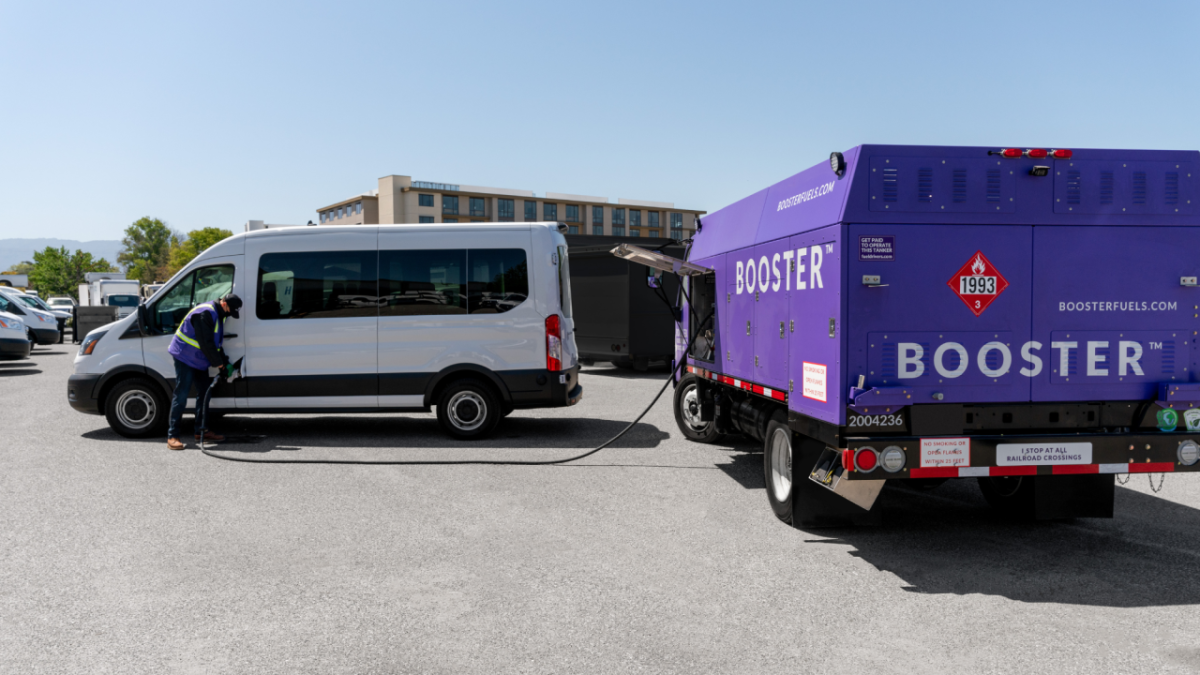The U.S. Transportation Decarbonization Blueprint Outlines a Bright Future for Sustainable Fuels, Mobile Fuel Delivery
Decarbonizing transportation will require a range of innovative, adaptable sustainability solutions, including Booster’s mobile fuel delivery service.

In late 2022, the Department of Energy (DOE), the Department of Transportation (DOT), the Environmental Protection Agency (EPA) and the Department of Housing and Urban Development (HUD) joined forces to create the U.S. National Blueprint for Transportation Decarbonization, a roadmap for how the United States can address greenhouse gas (GHG) emissions and the climate crisis through the transportation sector.
The blueprint is founded on five guiding principles:
- Implement bold actions to achieve measurable results
- Embrace creative solutions across the entire transportation system
- Ensure safety, equity and access
- Increase collaboration among DOE, DOT, EPA, HUD and other federal partners
- Establish U.S. leadership
As the nation comes together to work toward these principles, mobile fueling and sustainable fuels have the potential to be key players. Across decades-long journey to restructuring transportation, Booster stands ready to support a range of clean solutions and drive innovation toward a cleaner, greener landscape.
The Promise of Sustainable Fuels
While bold actions and creative solutions are key principles of the blueprint, there are myriad ways the plan seeks to put these concepts into action, from shepherding the rollout of electric vehicles and the slow retirement of internal combustion engines, to boosting nationwide reliance on public transportation. Across all the initiatives outlined, one theme connects them all: the transition will be iterative. Along the way, sustainable fuels will play a changing role in leading, supporting and even sometimes driving decarbonization across sectors.
The blueprint explains that the transition to decarbonizing transportation — especially light-, medium- and heavy-duty vehicles — will retire addressing EV charging needs, developing clean fuel infrastructure to ensure every person has adequate access, and developing drop-in, energy dense sustainable fuels for certain applications.
According to the blueprint, today’s transportation system relies on petroleum fuels for more than 95% of its energy use. To quickly reduce that number while electrification infrastructure scales and ICE vehicles are phased out, drop in sustainable fuels like renewable diesel can be highly beneficial to fleets.
“The historically slow turnover rate for many MHDVs [medium- to heavy-duty vehicles] means that new technologies may not replace diesel engines for several decades and that disseminating new technology across the MHDV fleet will be a slow process if market forces or policy decisions do not accelerate vehicle turnover,” explains the blueprint. “Sustainable fuels could help alleviate this turnover challenge by providing low-carbon solutions that are compatible with existing vehicles.”
The Potential of Mobile Fuel Delivery
Realistically, if these sustainable fuels are to continue to grow in adoption, they must be easily accessible to fleets. Mobile fuel delivery systems can help. In fact, mobile fuel delivery is perfectly poised to support the blueprint’s three key principles to achieve decarbonization of the sector: increase convenience, improve efficiency, and transition to clean options.
As the report explains, decarbonizing transportation will require that we “increase convenience by implementing system level design solutions that prioritize access and proximity to work opportunities, community services, and entertainment options to reduce unnecessary or excess movement of people and goods while still meeting all mobility needs.”
Mobile fuel delivery is a perfect example of this system level design solution. Currently, most fleet vehicles rely on off-route gas station errands to fill their fuel tanks. This means a fleet of 100 might see 100 individual trips to the gas station each day, which average about 2.2 off-route miles each. The extra drive time and fuel burned by each vehicle multiply quickly — to an average of 260 lbs of GHG emissions per vehicle per year just from traveling to and from the gas station. These extra trips also clog roads unnecessarily, keeping other vehicles running longer and raising their overall emissions.
Mobile fuel delivery addresses this problem by delivering energy directly from the terminal to the vehicles during non-operating hours, reducing overall trips to the gas station. This model can service traditional internal combustion engine vehicles with conventional or sustainable fuels.
Over the longer term, this model can accommodate zero-emission vehicles by placing modular solutions like mobile electric vehicle (EV) charging hubs or portable hydrogen fueling stations at or near fleet yards, transportation hubs, or distribution centers. In both scenarios, mobile fuel delivery eliminates or reduces the need for gas station errands by fleet drivers to significantly reduce emissions with an innovative, adaptable solution.
Transforming Transportation
As businesses, consumers and government entities work together on decarbonizing transportation, widespread adoption will remain dependent on the ability of consumers and businesses to incorporate new technologies and solutions into their lives and operations with efficiency and ease.
While mobile fuel delivery and sustainable fuels offer significant decarbonization potential, few businesses are currently in a position to adopt a sustainability solution that does not save money, drive efficiency or ease the workday for employees. The ability of mobile energy delivery to meet all these needs while also driving sustainability is what gives it the unique position in the coming transportation transition. Paired with drop-in sustainable fuels like renewable diesel, mobile fuel delivery can drive decarbonization and adoption of new technologies.
As the blueprint states, “emerging business models and technologies will shape the future of the transportation sector.” By offering mobile energy delivery and expanded access to renewable fuels, Booster is in a unique position to help shape that very future.

